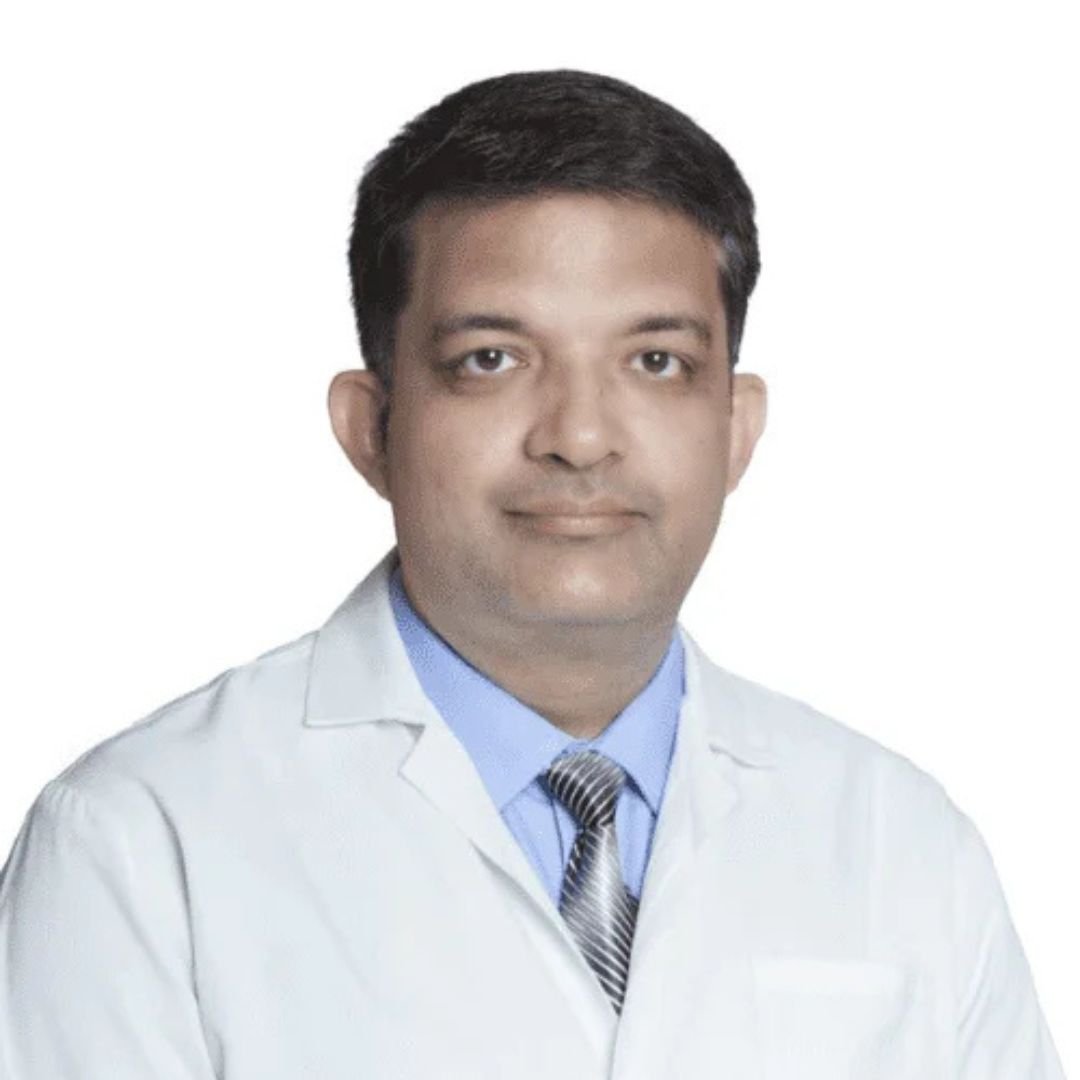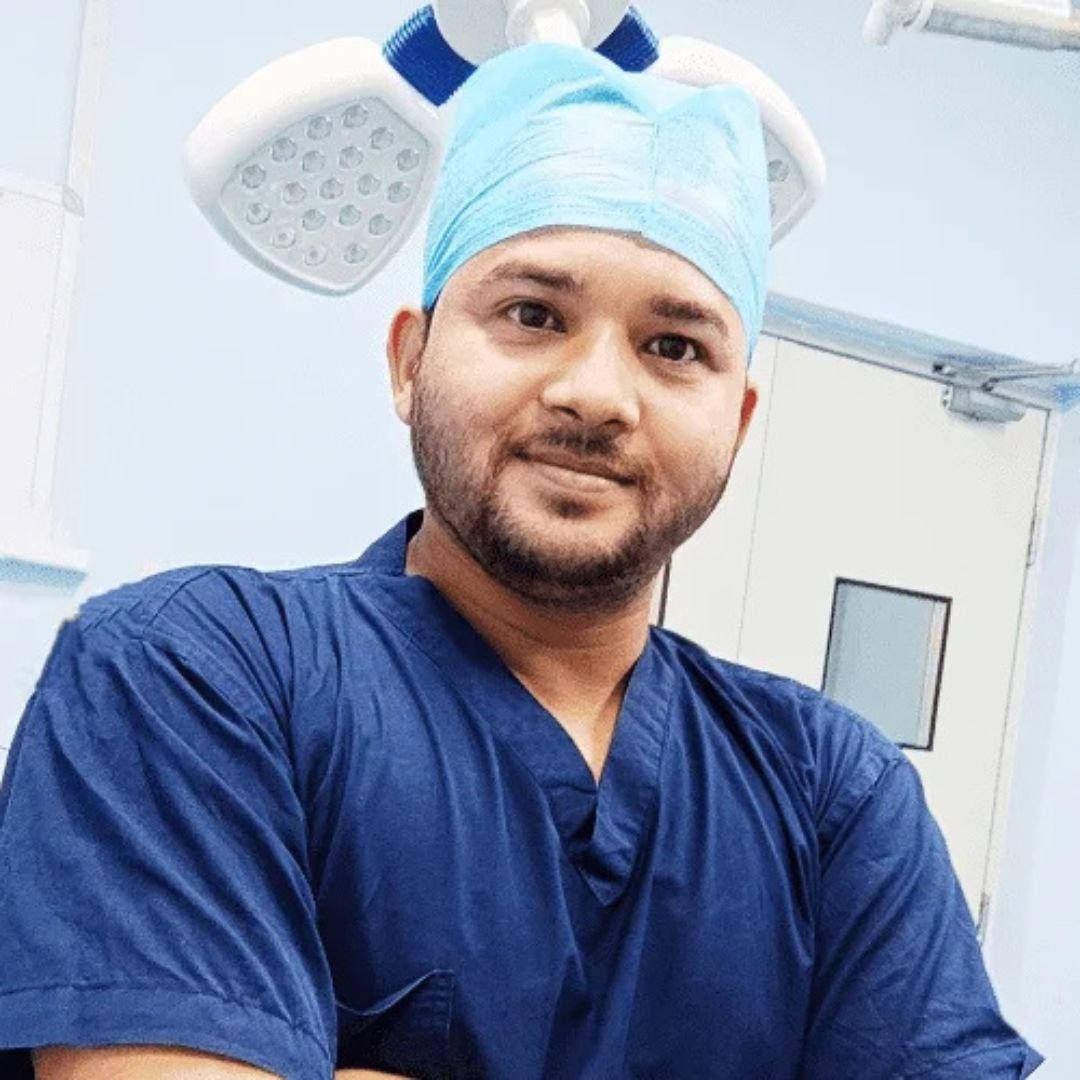Gynecomastia Surgery | Man Boobs Reduction
Do you feel your chest is increasing in size and resembling female breasts? These symptoms may indicate gynecomastia (man boobs), a condition that can be physically and emotionally challenging for men. Enlarged breasts can lead to self-consciousness and impact confidence. If you’re struggling with this, you’re not alone—gynecomastia affects many men worldwide.
At Bharatkare, we offer advanced gynecomastia surgery and personalized care to help you achieve a flatter, more masculine chest. Whether you’re exploring gynecomastia treatment without surgery or considering surgical options, our gynecomastia specialists are here to guide you every step of the way.
Book Appointments With Our Expert Doctors Near You
- Get consultation for 50+ diseases across India
- In-person and online consultation with experienced doctors
- Extensive medical assistance throughout your treatment


Dr Ashish Sachdeva
MBBS, MS - General Surgery, General Surgeon, Bariatric Surgeon, Laparoscopic Surgeon
4.9/5
20 Years Experience
Vadodara, India

Dr. Tanmay Jain
General Surgeon, Laparoscopic Surgeon and Proctologist
4.9/5
12 Years Experience
Jaipur, India

Dr. Vikram Vasuniya
MBBS, MS (General Surgery) General Laparoscopic & Laser Surgeon, Laser Proctologist
4.9/5
14 Years Experience
Bhopal, India

Dr. Sujeet Kumar Bharti
MBBS, MS (General Surgery) General Laparoscopic & Laser Surgeon, Laser Proctologist
4.9/5
22 Years Experience
Patna, India
What is Gynecomastia?
Gynecomastia, commonly referred to as “man boobs,” is a condition characterized by the enlargement of breast tissue in males. It can affect one or both breasts and is often caused by an imbalance between the hormones estrogen and testosterone. While it is not a life-threatening condition, gynecomastia can lead to emotional distress, self-esteem issues, and social anxiety. Understanding the difference between gynecomastia and chest fat is crucial, as the two conditions require different approaches for treatment. Gynecomastia involves glandular tissue, whereas chest fat is simply an accumulation of adipose tissue.
The condition can occur at any age and may be triggered by various factors, including hormonal changes, certain medications, or underlying health conditions. For those seeking effective solutions, gynecomastia surgery is often the most reliable option. At Bharatkare, we specialize in providing personalized care and advanced surgical techniques to help you achieve a more masculine chest contour.
Disease name
Enlarged Male Breasts (Man boobs)
Surgery name
Gynecomastia (Male Breast Reduction Surgery)
Duration
1 - 2 hours
Treated by
Plastic surgeon
Types of Gynecomastia
Gynecomastia is not a one-size-fits-all condition. It manifests in different forms, and understanding the types of gynecomastia is essential for determining the most appropriate treatment. The primary types include:
- True Gynecomastia: This involves the growth of glandular breast tissue and is often caused by hormonal imbalances. It is the most common type and typically requires surgical intervention for correction.
- Pseudogynecomastia: This type is characterized by the accumulation of fat in the chest area, giving the appearance of enlarged breasts. Unlike true gynecomastia, it does not involve glandular tissue and can sometimes be addressed through gynecomastia exercise and weight loss.
- Unilateral Gynecomastia: In some cases, the condition affects only one breast, leading to asymmetry. This is referred to as gynecomastia one side and may require targeted treatment.
- Adolescent Gynecomastia: Commonly seen during puberty, this type is usually temporary and resolves on its own. However, if it persists, medical intervention may be necessary.
- Drug-Induced Gynecomastia: Certain medications, such as anabolic steroids, anti-androgens, and some antidepressants, can lead to breast tissue growth. Identifying drugs causing gynecomastia is crucial for effective management.
At Bharatkare, our gynecomastia specialists conduct thorough evaluations to determine the type and severity of your condition, ensuring a tailored treatment plan.
How to Identify Gynecomastia
Many men struggle with distinguishing between gynecomastia and chest fat. If you’re wondering how to identify gynecomastia, here are some key indicators:
- Firmness: Gynecomastia typically feels firm or rubbery to the touch, whereas chest fat is softer.
- Location: The tissue in gynecomastia is usually concentrated beneath the nipple area, while fat is distributed more evenly across the chest.
- Pain or Tenderness: Some men with gynecomastia experience discomfort or sensitivity in the breast area.
- Nipple Changes: In some cases, the nipples may appear puffy or protrude more than usual.
If you’re unsure about your condition, you can learn how to check gynecomastia at home by performing a simple self-examination. However, for an accurate diagnosis, it’s best to consult a gynecomastia doctor near you. At Bharatkare, our team of experienced gynecomastia doctors uses advanced diagnostic tools, including gynecomastia radiology, to confirm the presence of glandular tissue and recommend the most effective treatment options.
Gynecomastia vs Chest Fat: Understanding the Difference
One of the most common questions we encounter is about the difference between gynecomastia and chest fat. While both conditions can result in a similar appearance, they are fundamentally different. Gynecomastia involves the growth of glandular breast tissue, often due to hormonal imbalances, whereas chest fat is simply an accumulation of excess fat in the chest area.
For those struggling with chest fat, lifestyle changes such as gynecomastia exercise and weight loss can often yield significant improvements. However, true gynecomastia usually requires medical intervention, such as surgery, to achieve the desired results. Understanding this distinction is crucial for choosing the right treatment approach.
At Bharatkare, we offer comprehensive consultations to help you determine whether your condition is gynecomastia or chest fat. Our gynecomastia specialists will guide you through the process, ensuring you receive the most appropriate care.
Gynecomastia Treatment Without Surgery
While gynecomastia surgery is the most effective solution for many men, some may prefer non-surgical options. If you’re exploring gynecomastia treatment without surgery, here are some alternatives:
- Lifestyle Changes: Adopting a healthy diet and regular exercise routine can help reduce chest fat and improve overall body composition. However, this approach is more effective for pseudogynecomastia than true gynecomastia.
- Medications: In some cases, hormonal therapies or medications can help address the underlying causes of gynecomastia. However, these treatments are typically more effective when the condition is diagnosed early.
- Gynecomastia Exercise: Targeted exercises, such as chest presses and push-ups, can help tone the chest muscles and reduce the appearance of excess tissue. While exercise alone may not eliminate glandular tissue, it can enhance the results of other treatments.
- Gynecomastia Treatment at Home: Some men opt for home remedies, such as compression garments or topical creams, to manage mild cases of gynecomastia. However, these methods are not a substitute for professional medical care.
At Bharatkare, we understand that surgery is not the right choice for everyone. Our gynecomastia specialists will work with you to explore non-surgical options and determine the best course of action based on your unique needs.
Gynecomastia Surgery: What to Expect
For many men, gynecomastia surgery is the most effective way to achieve a flatter, more masculine chest. The procedure, also known as male breast reduction, involves the removal of excess glandular tissue and fat. Here’s what you can expect during the process:
- Consultation: Your journey begins with a consultation with a gynecomastia surgeon in Delhi or your local area. During this visit, the surgeon will evaluate your condition, discuss your goals, and explain the surgical options.
- Procedure: The surgery is typically performed under general anesthesia and takes about 1-2 hours, depending on the extent of tissue removal. The surgeon may use liposuction, excision, or a combination of both techniques to achieve the desired results.
- Recovery: After the procedure, you’ll need to wear a compression garment to minimize swelling and support the healing process. Most patients can return to light activities within a week, but full recovery may take several weeks.
- Results: The results of gynecomastia surgery before and after are often dramatic, with patients experiencing a significant improvement in chest contour and self-confidence.
At Bharatkare, we prioritize patient safety and satisfaction. Our team of gynecomastia doctors is dedicated to providing the highest standard of care, ensuring a smooth and successful surgical experience.
Gynecomastia Surgery Recovery Time
One of the most common concerns for patients considering gynecomastia surgery is the gynecomastia surgery recovery time. Understanding what to expect during the recovery process can help you prepare and ensure a smooth healing journey. Here’s a detailed breakdown:
- Immediate Post-Surgery: After the procedure, you will be monitored in a recovery room for a few hours. You may experience mild discomfort, swelling, and bruising, which are normal. Pain medication will be prescribed to manage any discomfort.
- First Week: During the first week, it’s essential to rest and avoid strenuous activities. Most patients can return to light activities within a few days, but it’s crucial to follow your surgeon’s advice. Wearing a compression garment is mandatory during this period to reduce swelling and support the healing process.
- 2-4 Weeks: By the second week, most of the swelling and bruising will subside. You may start to see the initial results of the surgery. However, it’s still important to avoid heavy lifting and intense physical activities.
- 6 Weeks and Beyond: By the sixth week, most patients can resume their normal activities, including exercise. However, full recovery and final results may take a few months. It’s essential to attend follow-up appointments with your gynecomastia surgeon in Delhi to monitor your progress.
At Bharatkare, we provide comprehensive post-operative care instructions to ensure a smooth recovery. Our team is always available to address any concerns you may have during the healing process.
Gynecomastia Surgery Scars
Another common concern among patients is the appearance of gynecomastia surgery scars. While scarring is an inevitable part of any surgical procedure, our gynecomastia specialists take great care to minimize their visibility. Here’s what you need to know:
- Scar Placement: The incisions for gynecomastia surgery are typically made around the areola or in the natural creases of the chest. This strategic placement helps to conceal the scars, making them less noticeable.
- Scar Care: Proper scar care is essential for optimal healing. Your surgeon will provide detailed instructions on how to care for your incisions, including keeping the area clean and applying prescribed ointments.
- Scar Maturation: Over time, scars will fade and become less prominent. This process, known as scar maturation, can take several months to a year. Using silicone sheets or gels can help speed up this process.
- Minimizing Scars: To further minimize the appearance of scars, it’s crucial to follow all post-operative care instructions and avoid sun exposure to the incision sites.
At Bharatkare, we prioritize achieving natural-looking results with minimal scarring. Our gynecomastia surgeons use advanced techniques to ensure the best possible outcomes for our patients.
Is Gynecomastia Surgery Painful?
Many patients wonder, “Is gynecomastia surgery painful?” While discomfort is a natural part of any surgical procedure, the pain associated with gynecomastia surgery is generally manageable. Here’s what you can expect:
- During Surgery: The procedure is performed under general anesthesia, so you will not feel any pain during the surgery.
- Immediate Post-Surgery: After the anesthesia wears off, you may experience mild to moderate discomfort. Pain medication will be prescribed to help manage this.
- First Few Days: The first few days after surgery are typically the most uncomfortable. However, most patients report that the pain is manageable with the prescribed medication.
- Long-Term Discomfort: Any residual discomfort usually subsides within a week or two. Most patients find that the benefits of the surgery far outweigh the temporary discomfort.
At Bharatkare, we prioritize patient comfort and provide comprehensive pain management strategies to ensure a smooth recovery.
Gynecomastia After Surgery: What to Expect
Understanding what to expect gynecomastia after surgery can help you prepare for the recovery process and set realistic expectations. Here’s a detailed overview:
- Immediate Results: While you will notice an immediate improvement in chest contour, the final results will take time to fully develop as swelling subsides.
- Swelling and Bruising: Swelling and bruising are normal after surgery and will gradually decrease over the first few weeks.
- Compression Garment: Wearing a compression garment is essential for reducing swelling and supporting the healing process. You will need to wear it for several weeks post-surgery.
- Activity Restrictions: It’s important to avoid strenuous activities and heavy lifting for at least 4-6 weeks to ensure proper healing.
- Follow-Up Appointments: Regular follow-up appointments with your gynecomastia specialist are crucial for monitoring your progress and addressing any concerns.
At Bharatkare, we provide detailed post-operative care instructions and are always available to support you throughout your recovery journey.
Gynecomastia Weight Loss: Can It Help?
For some men, gynecomastia weight loss can help reduce the appearance of enlarged breasts, especially in cases of pseudogynecomastia. Here’s how weight loss can impact gynecomastia:
- Reducing Chest Fat: Losing weight can help reduce the amount of fat in the chest area, leading to a flatter and more masculine appearance.
- Improving Overall Health: Maintaining a healthy weight can improve your overall health and reduce the risk of developing other health conditions.
- Enhancing Surgical Results: For those considering gynecomastia surgery, achieving a stable weight beforehand can enhance the results of the procedure.
However, it’s important to note that weight loss alone may not be sufficient for true gynecomastia, which involves glandular tissue. In such cases, surgical intervention may be necessary.
At Bharatkare, our gynecomastia specialists can help you develop a personalized plan that includes weight loss strategies and, if needed, surgical options to achieve your desired results.
Bodybuilder Gynecomastia: A Unique Challenge
Bodybuilder gynecomastia is a unique challenge faced by many athletes and fitness enthusiasts. The use of anabolic steroids and other performance-enhancing drugs can lead to the development of gynecomastia. Here’s what you need to know:
- Causes: Anabolic steroids can disrupt the balance of hormones in the body, leading to the growth of breast tissue. This is one of the primary drugs causing gynecomastia in bodybuilders.
- Prevention: Avoiding the use of anabolic steroids and other performance-enhancing drugs is the best way to prevent gynecomastia. If you’re considering using these substances, it’s essential to weigh the risks and benefits.
- Treatment: For bodybuilders who develop gynecomastia, gynecomastia surgery is often the most effective treatment option. The procedure can help restore a more masculine chest contour and improve self-confidence.
At Bharatkare, we understand the unique challenges faced by bodybuilders and offer specialized care to address their specific needs. Our gynecomastia surgeons are experienced in treating gynecomastia caused by steroid use and can help you achieve the best possible results.
Gynecomastia Surgery Cost in Delhi
One of the most frequently asked questions is about the gynecomastia surgery cost in Delhi. While the exact cost can vary depending on several factors, it’s important to understand what influences the pricing and what you can expect when considering this procedure. Here’s a detailed breakdown:
- Surgeon’s Expertise: The experience and reputation of the gynecomastia surgeon in Delhi play a significant role in determining the cost. Highly skilled surgeons with a proven track record may charge more for their services.
- Facility Fees: The type of facility where the surgery is performed also affects the cost. Advanced surgical centers with state-of-the-art equipment and amenities may have higher fees.
- Extent of Surgery: The complexity of the procedure, including the amount of tissue to be removed and the techniques used, can influence the overall cost. For example, cases requiring both liposuction and excision may be more expensive.
- Anesthesia Fees: The cost of anesthesia is another factor to consider. General anesthesia, which is commonly used for gynecomastia surgery, may be more expensive than local anesthesia.
- Post-Operative Care: Follow-up appointments, compression garments, and any additional treatments required during the recovery period can also add to the overall cost.
At Bharatkare, we believe in transparency and will provide you with a detailed breakdown of the gynecomastia surgery cost in Delhi during your consultation. Our goal is to offer high-quality care at competitive prices, ensuring you receive the best value for your investment.
Gynecomastia Surgery Cost in India
For those considering gynecomastia surgery cost in India, it’s important to note that the cost can vary significantly depending on the city and the facility. Here’s a closer look at the factors that influence the cost:
- Geographical Location: The cost of living and medical services can vary widely across different cities in India. Metropolitan cities like Delhi, Mumbai, and Bangalore may have higher costs compared to smaller cities.
- Hospital Reputation: Renowned hospitals and surgical centers with a strong reputation for excellence may charge more for their services. However, these facilities often provide a higher standard of care and better outcomes.
- Surgical Techniques: The specific techniques used during the surgery, such as liposuction, excision, or a combination of both, can impact the overall cost. Advanced techniques may come with a higher price tag.
- Additional Services: Some facilities offer comprehensive packages that include pre-operative consultations, post-operative care, and follow-up appointments. These packages may be more expensive but provide added convenience and peace of mind.
At Bharatkare, we strive to make gynecomastia surgery accessible to everyone. Our team will work with you to develop a personalized treatment plan that fits your budget while ensuring the highest standard of care.
Gynecomastia Radiology: Diagnostic Tools for Accurate Assessment
Accurate diagnosis is the cornerstone of effective treatment. Gynecomastia radiology plays a crucial role in assessing the condition and determining the best course of action. Here’s how radiology aids in the diagnosis and treatment of gynecomastia:
- Mammography: This imaging technique is commonly used to evaluate breast tissue. It helps distinguish between glandular tissue and fat, providing a clear picture of the condition.
- Ultrasound: Ultrasound imaging is another valuable tool for assessing gynecomastia. It can help identify the presence of glandular tissue and rule out other conditions, such as tumors or cysts.
- MRI: In some cases, magnetic resonance imaging (MRI) may be used to obtain detailed images of the breast tissue. This is particularly useful for complex cases or when other imaging techniques are inconclusive.
- Biopsy: Although less common, a biopsy may be performed to rule out malignancy. This involves taking a small sample of tissue for laboratory analysis.
At Bharatkare, our gynecomastia specialists utilize advanced radiological tools to ensure an accurate diagnosis and develop a tailored treatment plan. Our state-of-the-art imaging facilities provide the highest level of precision and reliability.
Gynecomastia Surgery in Delhi: Why Choose Bharatkare?
If you’re considering gynecomastia surgery in Delhi, it’s essential to choose a facility that offers expertise, advanced technology, and personalized care. Here’s why Bharatkare stands out as a leading choice for gynecomastia treatment:
- Experienced Surgeons: Our team of gynecomastia surgeons in Delhi is highly skilled and experienced in performing male breast reduction surgeries. We have a proven track record of successful outcomes and satisfied patients.
- Advanced Techniques: We utilize the latest surgical techniques and technologies to ensure the best possible results. Our approach is tailored to each patient’s unique needs, ensuring a personalized treatment plan.
- Comprehensive Care: From the initial consultation to post-operative follow-up, we provide comprehensive care at every step of the journey. Our team is dedicated to ensuring a smooth and comfortable experience for our patients.
- State-of-the-Art Facilities: Our surgical centers are equipped with state-of-the-art technology and amenities, providing a safe and comfortable environment for your procedure.
- Patient-Centered Approach: At Bharatkare, we prioritize patient satisfaction and well-being. We take the time to understand your concerns and goals, ensuring you receive the care and attention you deserve.
Choosing Bharatkare for your gynecomastia surgery in Delhi means choosing excellence, expertise, and a commitment to achieving the best possible results.
Gynecomastia Surgery Before and After: Realistic Expectations
Understanding what to expect gynecomastia surgery before and after can help you set realistic expectations and prepare for the journey ahead. Here’s a detailed overview:
- Before Surgery: During your consultation, your surgeon will evaluate your condition, discuss your goals, and explain the surgical options. You’ll receive detailed instructions on how to prepare for the procedure, including any necessary pre-operative tests.
- Day of Surgery: The procedure typically takes 1-2 hours and is performed under general anesthesia. You’ll be monitored in a recovery room for a few hours before being discharged.
- After Surgery: You’ll need to wear a compression garment to reduce swelling and support the healing process. Most patients can return to light activities within a week, but full recovery may take several weeks.
- Long-Term Results: The final results of gynecomastia surgery will become apparent as swelling subsides and the chest contour settles. Most patients experience a significant improvement in their appearance and self-confidence.
At Bharatkare, we provide detailed pre- and post-operative care instructions to ensure a smooth and successful recovery. Our team is always available to address any concerns and support you throughout your journey.
Gynecomastia Treatment at Home: Is It Effective?
For men seeking non-surgical solutions, exploring gynecomastia treatment at home can be an appealing option. While home remedies may not completely eliminate glandular tissue, they can help manage mild cases or improve overall chest appearance. Here’s a closer look at some common approaches:
- Diet and Nutrition: A balanced diet rich in lean proteins, healthy fats, and whole grains can help reduce overall body fat, including chest fat. Avoiding processed foods, sugary drinks, and excessive alcohol can also support hormonal balance.
- Herbal Supplements: Some men turn to herbal supplements like turmeric, green tea extract, or flaxseed to reduce inflammation and support hormonal health. However, it’s essential to consult a healthcare professional before starting any supplements, as they may interact with medications or have side effects.
- Topical Creams: Certain creams containing ingredients like retinol or caffeine are marketed for reducing chest fat. While these may provide temporary tightening of the skin, they are unlikely to address the underlying glandular tissue.
- Compression Garments: Wearing compression shirts or vests can help flatten the chest and improve posture, providing a temporary solution for those seeking immediate results.
- Stress Management: Chronic stress can disrupt hormone levels, potentially exacerbating gynecomastia. Practices like yoga, meditation, and deep breathing exercises can help manage stress and promote overall well-being.
While gynecomastia treatment at home can be beneficial for mild cases or as a complementary approach, it’s important to note that these methods may not be sufficient for true gynecomastia. For more significant results, consulting a gynecomastia specialist is recommended.
Gynecomastia Exercise: Can It Help?
Many men wonder if gynecomastia exercise can reduce the appearance of enlarged breasts. While exercise alone cannot eliminate glandular tissue, it can help tone the chest muscles and reduce chest fat, particularly in cases of pseudogynecomastia. Here are some effective exercises to consider:
- Push-Ups: This classic exercise targets the chest, shoulders, and triceps, helping to build muscle and improve chest definition.
- Bench Press: Using dumbbells or a barbell, the bench press is an excellent way to strengthen the pectoral muscles. Start with lighter weights and gradually increase as you build strength.
- Chest Flys: This exercise isolates the chest muscles, helping to improve muscle tone and reduce the appearance of excess tissue.
- Incline Press: Performing chest presses on an incline bench targets the upper chest, creating a more balanced and defined appearance.
- Cardio Exercises: Incorporating cardio activities like running, cycling, or swimming can help burn overall body fat, including chest fat.
While gynecomastia exercise can improve chest appearance, it’s important to maintain realistic expectations. For true gynecomastia, surgical intervention may be necessary to achieve the desired results. At Bharatkare, our gynecomastia specialists can help you develop a personalized fitness plan to complement your treatment.
Which Doctor to Consult for Gynecomastia?
If you’re experiencing symptoms of gynecomastia, knowing which doctor to consult for gynecomastia is crucial for accurate diagnosis and effective treatment. Here’s a guide to help you find the right specialist:
- Gynecomastia Specialist: A gynecomastia specialist is a surgeon with expertise in male breast reduction procedures. They can evaluate your condition, recommend appropriate treatment options, and perform the surgery if needed.
- Endocrinologist: Since gynecomastia is often linked to hormonal imbalances, consulting an endocrinologist can help identify underlying causes, such as low testosterone or elevated estrogen levels.
- General Physician: Your primary care doctor can perform an initial evaluation and refer you to a specialist if necessary. They can also help rule out other potential causes of breast enlargement.
- Radiologist: In some cases, imaging studies like mammograms or ultrasounds may be required to confirm the diagnosis. A radiologist can assist in interpreting these results.
At Bharatkare, our team includes experienced gynecomastia doctors and specialists who work together to provide comprehensive care. We ensure that every patient receives a thorough evaluation and personalized treatment plan.
1 Week After Gynecomastia Surgery: What to Expect
The first week after gynecomastia surgery is a critical period for recovery. Knowing what to expect can help you prepare and ensure a smooth healing process. Here’s a detailed overview:
- Immediate Post-Surgery: After the procedure, you’ll be monitored in a recovery room for a few hours. You may experience mild discomfort, swelling, and bruising, which are normal.
- Pain Management: Pain medication will be prescribed to manage any discomfort. Most patients find that the pain is manageable and subsides within a few days.
- Compression Garment: Wearing a compression garment is essential during the first week to reduce swelling and support the healing process. You’ll need to wear it continuously, except when showering.
- Activity Restrictions: It’s important to avoid strenuous activities and heavy lifting during the first week. Light activities, such as walking, are encouraged to promote circulation.
- Follow-Up Appointment: You’ll have a follow-up appointment with your gynecomastia surgeon to monitor your progress and address any concerns.
At Bharatkare, we provide detailed post-operative care instructions and are always available to support you during your recovery. Our goal is to ensure a comfortable and successful healing process.
Gynecomastia Surgery Scars: Minimizing Their Appearance
Scarring is a natural part of any surgical procedure, but there are steps you can take to minimize the appearance of gynecomastia surgery scars. Here’s how:
- Proper Wound Care: Keeping the incision sites clean and following your surgeon’s instructions for wound care is essential for optimal healing.
- Scar Creams and Gels: Using silicone-based creams or gels can help reduce the visibility of scars. These products are typically applied once the incisions have fully healed.
- Sun Protection: Protecting the scarred areas from sun exposure is crucial, as UV rays can darken scars and make them more noticeable. Use sunscreen or cover the area with clothing when outdoors.
- Massage Therapy: Gently massaging the scarred areas can help improve blood flow and promote healing. This should only be done after the incisions have fully healed and with your surgeon’s approval.
- Laser Treatments: In some cases, laser treatments may be recommended to further reduce the appearance of scars. These treatments are typically performed by a dermatologist or plastic surgeon.
At Bharatkare, our gynecomastia surgeons take great care to place incisions in discreet locations and provide detailed scar care instructions to ensure the best possible results.
Gynecomastia vs Fat: Understanding the Key Differences
Understanding the difference between gynecomastia and chest fat is essential for choosing the right treatment approach. Here’s a detailed comparison:
- Tissue Composition: Gynecomastia involves the growth of glandular breast tissue, while chest fat is simply an accumulation of adipose tissue.
- Firmness: Gynecomastia typically feels firm or rubbery to the touch, whereas chest fat is softer and more pliable.
- Location: The tissue in gynecomastia is usually concentrated beneath the nipple area, while fat is distributed more evenly across the chest.
- Treatment Options: Chest fat can often be reduced through diet, exercise, and weight loss, while gynecomastia usually requires surgical intervention for significant improvement.
At Bharatkare, our gynecomastia specialists conduct thorough evaluations to determine whether your condition is gynecomastia or chest fat, ensuring you receive the most appropriate treatment.
Questions to Ask Your Surgeon
Before undergoing gynecomastia surgery, it’s important to have a detailed discussion with your surgeon. Here are some questions to consider:
- What is your experience with gynecomastia surgery?
Ask about the surgeon’s qualifications, years of experience, and success rates with male breast reduction procedures. - What surgical technique do you recommend for my case?
Understand whether liposuction, excision, or a combination of both is best suited for your condition. - What are the potential risks and complications?
Discuss the possible risks and how they can be minimized. - What should I expect during recovery?
Ask about the recovery timeline, activity restrictions, and post-operative care instructions. - Can I see before-and-after photos of your previous patients?
Reviewing photos can help you gauge the surgeon’s skill and set realistic expectations. - What is the total cost of the procedure?
Request a detailed breakdown of the costs, including surgeon fees, facility fees, anesthesia, and post-operative care. - How long will the results last?
Understand the longevity of the results and what steps you can take to maintain them. - What happens if I’m not satisfied with the results?
Discuss the possibility of revision surgery and any associated costs. - Do you offer financing options?
If cost is a concern, inquire about payment plans or financing options. - What should I do to prepare for surgery?
Get detailed instructions on pre-operative preparations, including dietary restrictions and medication adjustments.
At Bharatkare, we encourage open communication and are happy to address all your questions and concerns. Our goal is to ensure you feel confident and informed throughout your treatment journey.
Why Choose Bharatkare for Gynecomastia Surgery?
Choosing the right facility for your gynecomastia surgery is crucial for achieving the best results. Here’s why Bharatkare is the preferred choice for countless patients:
- Expert Surgeons: Our team of gynecomastia specialists has extensive experience in male breast reduction procedures, ensuring safe and effective outcomes.
- Personalized Care: We tailor each treatment plan to the patient’s unique needs, ensuring a customized approach for optimal results.
- Advanced Techniques: We use the latest surgical techniques and technologies to minimize scarring, reduce recovery time, and deliver natural-looking results.
- Comprehensive Support: From the initial consultation to post-operative care, we provide end-to-end support to ensure a seamless experience.
- State-of-the-Art Facilities: Our surgical centers are equipped with cutting-edge technology and adhere to the highest standards of safety and hygiene.
- Transparent Pricing: We believe in transparency and provide a detailed breakdown of the gynecomastia surgery cost in Delhi and India, with no hidden fees.
- Proven Results: Our before-and-after gallery showcases the transformative results we’ve achieved for our patients, highlighting our commitment to excellence.
- Patient-Centric Approach: At Bharatkare, your comfort, safety, and satisfaction are our top priorities. We strive to make your journey as smooth and stress-free as possible.
Key Takeaways
Here are the essential points to remember about gynecomastia surgery and treatment:
- Gynecomastia is a common condition caused by hormonal imbalances, medications, or underlying health issues. It can affect one or both breasts and is different from chest fat.
- Surgery is the most effective solution for true gynecomastia, as it removes glandular tissue and fat to create a flatter, more masculine chest.
- Non-surgical options like diet, exercise, and medications may help manage mild cases or pseudogynecomastia but are often insufficient for significant results.
- Choosing an experienced surgeon is crucial for achieving the best outcomes. At Bharatkare, our gynecomastia specialists use advanced techniques to ensure natural-looking results.
- Recovery is manageable with proper care, including wearing a compression garment, avoiding strenuous activities, and attending follow-up appointments.
- Scarring is minimal when incisions are placed strategically and cared for properly. Most scars fade over time and become less noticeable.
- Realistic expectations are key. While surgery can dramatically improve chest contour, maintaining a healthy lifestyle is essential for long-term results.
- Bharatkare offers comprehensive care, from diagnosis to post-operative support, ensuring a smooth and successful treatment journey.
FAQ
You Can Find All Answers Here
Yes, the results of gynecomastia surgery are typically permanent, provided you maintain a stable weight and avoid factors like steroid use that can trigger a recurrence.
In most cases, gynecomastia does not return after surgery. However, weight gain, hormonal imbalances, or the use of certain medications can lead to a recurrence.
Most patients are advised to wear a compression garment for 4-6 weeks post-surgery to reduce swelling and support the healing process.
Like any surgical procedure, gynecomastia surgery carries some risks, such as infection, bleeding, or scarring. However, these risks are minimal when performed by an experienced gynecomastia surgeon.
Yes, some patients choose to combine gynecomastia surgery with other procedures like liposuction or abdominoplasty for a more comprehensive body contouring result.
In most cases, gynecomastia surgery is considered a cosmetic procedure and is not covered by insurance. However, if the condition causes significant pain or discomfort, coverage may be possible. Check with your insurance provider for details.
Light activities can usually be resumed within a week, but strenuous exercises and heavy lifting should be avoided for at least 4-6 weeks to ensure proper healing.
Gynecomastia surgery has a high success rate, with most patients achieving a flatter, more masculine chest contour and improved self-confidence.
Request a detailed breakdown of the costs, including surgeon fees, facility fees, anesthesia, and post-operative care.
If cost is a concern, inquire about payment plans or financing options.
Quick Links
Popular Surgeries
Find Us
© Copyright BharatKare 2025. All Right Reserved.



